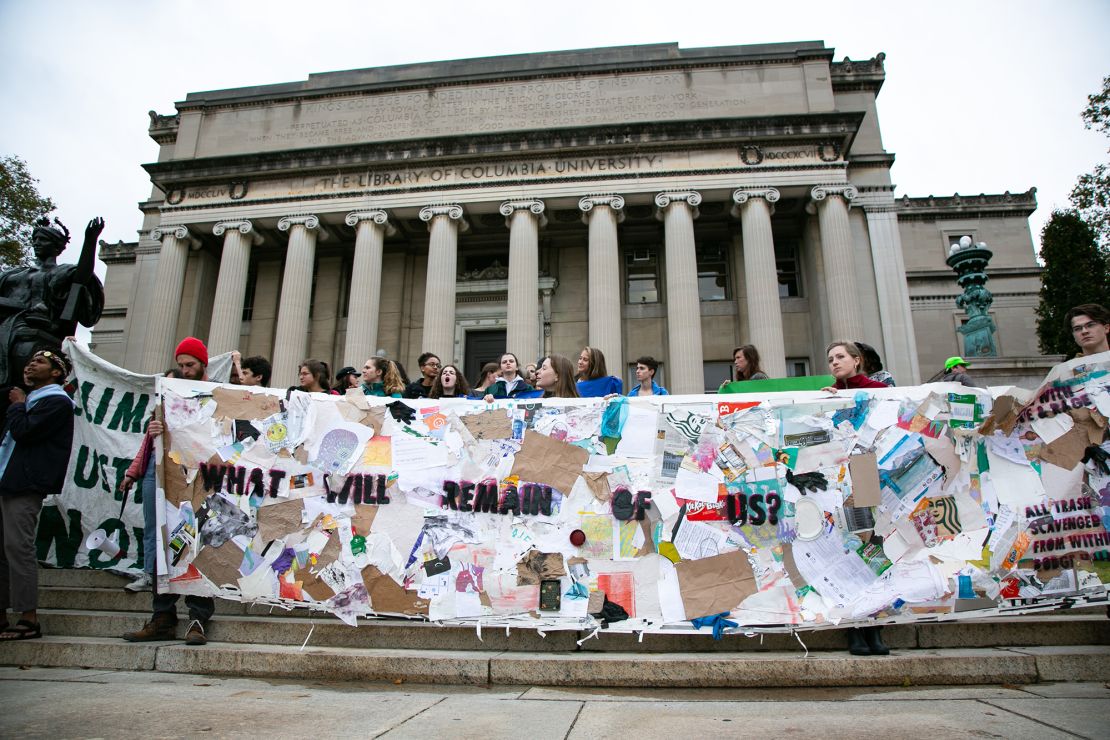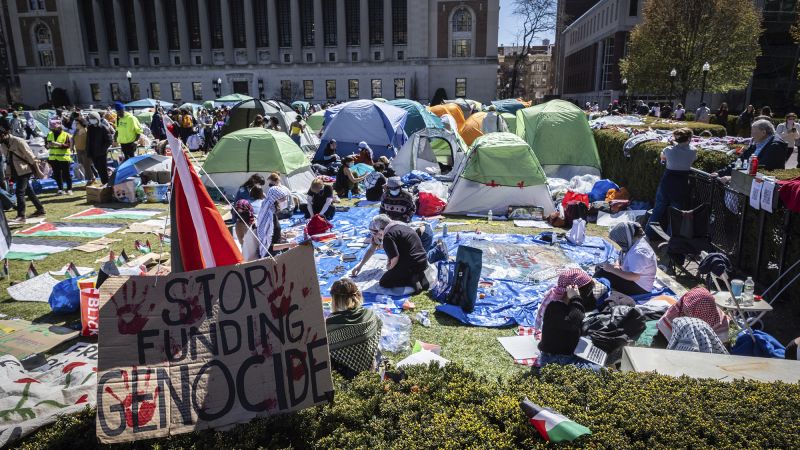One of the core demands over the past week by the pro-Palestinian student groups at Columbia University has been for the school to withdraw investment funds from what they describe as companies profiting from Israel’s military action in Gaza.
Columbia’s endowment is worth $13.6 billion and is managed by a university-owned investment firm.
The request from Columbia University Apartheid Divest — a coalition of student groups behind the movement — includes, among other steps, divesting endowment funds from several weapons manufacturers and tech companies that do business with Israel’s government. The group has described those companies as profiting “from Israeli apartheid, genocide, and military occupation of Palestine.” Israel denies accusations of genocide.
This is not the first time such demands have been made. Columbia has a history of student activism, from the now-famous 1968 student occupation of multiple campus buildings to raise awareness of the Vietnam War, to hunger strikes over issues such as the university’s expansion in Upper Manhattan.
And protesting students also have a history of pushing for Columbia to divest in different movements.
In 2000, the university established an advisory committee on socially responsible investing, made up of students, faculty and alumni, to provide feedback to the managers of Columbia’s endowment investments. The group has a formal process for submitting divestment proposals.
Columbia University Apartheid Divest submitted a formal proposal to the committee for withdrawing investments related to Israel in December, which has yet to yield success. Students at Columbia College, the university’s undergraduate school, voted to support the divestment proposal last week.
And students are continuing to push for the university to adopt the proposal.
“We are building on the legacy of decades of students who are called for freedom, for liberation, for equality and for an end to apartheid systems across the world … for all oppressed peoples,” Columbia student organizer Catherine Elias told CNN earlier this week.
Currently, Columbia lists five areas where it refrains from investing: tobacco, private prison operations, thermal coal, Sudan and fossil fuels — all decisions that were made in the past decade. But the school’s divestment history goes back even farther.
In the 1980s, a group of Columbia students began to call on the school to cut financial ties with companies doing business in South Africa over its apartheid racial segregation policy.
Daniel Armstrong, who founded the Coalition for a Free South Africa as a Columbia student in early 1980s and now owns a mentoring business in Los Angeles, said the effort began with fliers and guest speakers but grew in the subsequent years.
Students “began seeing that this isn’t a crazy position to have,” Armstrong told CNN. “Then our student newspaper began supporting it, which I thought was a huge step as far as legitimizing the demand for divestment.”
In 1983, Columbia’s student Senate approved the move to divest with nearly unanimous support, but the university’s trustees said no.
In April 1985, students led a three-week student demonstration against Columbia’s investments in South Africa, the New York Times reported at the time. The demonstration involved around 150 students blocking access to the entrance of a campus building.
Months after that protest, trustees voted to sell the majority of Columbia’s stock in American companies doing business in South Africa. That included a laundry list of investments in notable companies including American Express, Chevron, Ford and Coca-Cola, among others, which together totaled $39 million in stock and about 4% of Columbia’s total portfolio, the New York Times reported.
Columbia was the first Ivy League university to divest from South Africa, and various other colleges followed suit, including the University of California, Berkeley, as well as Johns Hopkins University and the University of North Carolina at Chapel Hill. South Africa’s apartheid ended in the early 1990s.
Since that time, student activists have successfully pushed Columbia to divest from several other areas.
In 2015, Columbia became the first US university to divest from private prison companies after a year-plus-long student activist campaign raising concerns about human rights abuses. The university sold its shares in G4S, the world’s largest private security firm, and Corrections Corporation of America, the largest private prison company in the United States.
In 2019, a group of Columbia students affiliated with the climate activism organization Extinction Rebellion staged a weeklong hunger strike in the library to encourage the university to go beyond an earlier commitment to divest from thermal coal and withdraw funds from all fossil fuels.

Despite some pushback from university leaders in the ensuing months, the group presented a formal divestment proposal to the socially responsible investing committee.
“People have criticized (these movements) for using the goal of divestment because it’s a symbolic goal and if the university divests then someone else will just buy those same shares,” said Savannah Pearson, who participated in the 2019 hunger strike as an undergraduate student at Columbia. But, she said, “symbols have a lot of power … and it can inspire other schools to do the same thing.”
The fossil fuel divestment proposal was approved by Columbia’s Board of Trustees in early 2021. The policy includes, among other things, a commitment not to invest in “companies whose primary business is the exploration and production of fossil fuels.” Columbia’s announcement was followed by student advocacy, and eventually similar commitments, at other Ivy League universities.
“A small group of students can transform an institution like Columbia University, but they can’t do it without support and buy-in from the wider community,” said Michael Cusack, who as a graduate student at Columbia’s Teachers College in 2019 helped to author the group’s proposal.
Read the full article here




